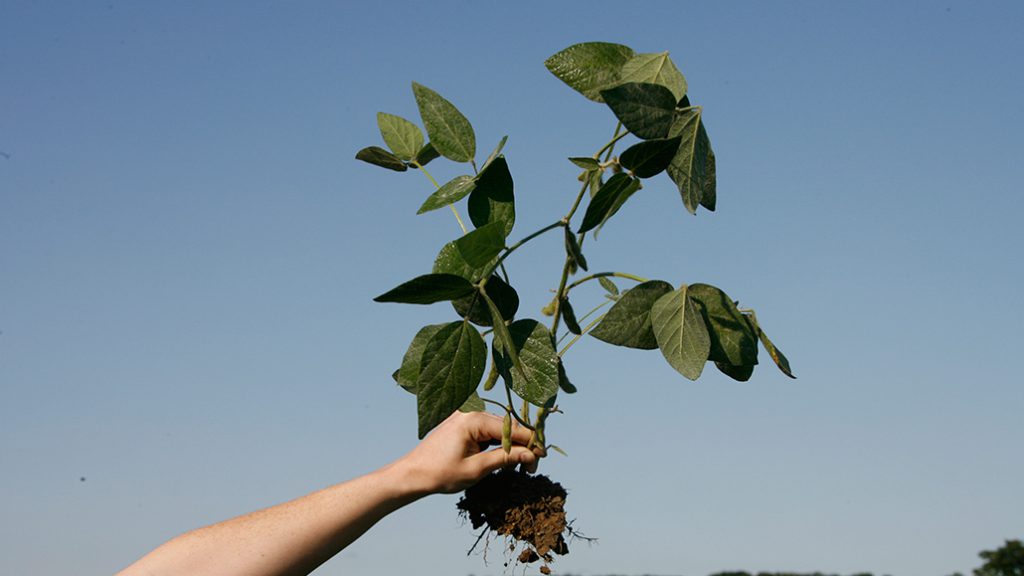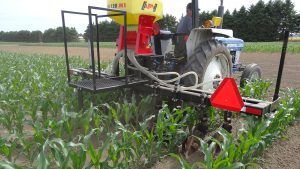Invite the microbes

MIKE DORION WANTS farmers to build healthy soil and grow better crops by throwing an underground party with guests that include a whole range of microbes.
“These organisms act like probiotics in the human gut system — breaking things down and making nutrients available to plants,” he says.
Dorion, also known as the ‘Compost Kid’, is a soil and microbiology mentor, owns Living Soil Solutions, and is a member of the Calgary Permaculture Guild. He described what microbes are in the soil and how they are crucial to its health to farmers who attended Crops Day during Grey-Bruce Farmers Week in January.
Two things he asked everyone to keep in mind throughout the presentation were that forests are balanced systems that don’t need extra water or fertilizer to survive, and that plants, like humans, need air, water, food, and shelter to thrive.
He started his talk by explaining that soil is made up of chemical, physical, and biological components and that it’s only been in the last five to 10 years that the role of soil biology has really been examined.
“If you pull up a plant and there’s soil clinging to the roots, you’re getting micro-aggregates that show it’s healthy,” he said. Bare roots mean the soil isn’t as healthy.
THE GUEST LIST
Using the party analogy, he said the rhizosphere around the roots of plants is where it happens and the roots themselves are the hosts, sending out ‘invitations’ called root exudates or signals that attract the beneficial guests.
The first to arrive are bacteria, the smallest organisms that use enzymes to eat simple sugars in the sand, silt, and clay and organic matter, and retain the nutrients — mainly nitrogen — in their microscopic bodies.
Next, the fungi show up, providing soil structure and helping with decomposition. They’re also really good at suppressing disease. Nematophage fungi send out ‘lassos’ and pheromones that mimic a sick root to attract parasitical nematodes. The nematodes then slip through the lasso, which the fungi tightens, squeezing the life out of them.
“Nature has already figured out how to bring things back to balance,” Dorion said, referring to the fungi’s ability to get rid of parasites.
Endomycorrhizal fungi attach themselves to plant roots at the cellular level and act as a conduit for water and phosphorus, which they ‘trade’ for the sugars the plant produces. These fungi fan out below the soil surface and can add as much as 20 to 30 per cent to the plant’s ability to take up nutrients and moisture.
Calcium is needed in plants to provide good cell structure, much like it helps humans to strengthen bones. Fungi work to move calcium from the soil into the roots.
Protozoa (ciliates, flagellates, and amoeba) are needed to eat the bacteria in the soil, which are carrying nutrients. In the right conditions, these guests can ‘eat’ between 5,000 and 10,000 bacteria a day. The waste they produce is in a form that is soluble, so the nutrients can be taken up by the plants. Protozoa need the right environment, including a good amount of organic matter, or they don’t show up.
The fourth wave of guests to come is nematodes, which are microscopic worms that help decompose organic material. They eat bacteria, fungi, and other nematodes, and recycle nutrients and minerals back into the soil where it’s available for plant roots to take up.
Organic matter is crucial to keep the microbiological party going when the plants are harvested or go dormant and are no longer supplying the sugars that feed the guests. It is also important because it acts as a sponge, retaining water that can be made available for plants. A one per cent increase in organic matter can make as much as 25,000 gallons of water per acre available for plants.
Rain pools on the surface or runs off soil that’s compacted and has little organic matter, which means the plants do not benefit from a good watering.
Worms are next in the soil microbe food chain and are among the last guests to come to the party. They are the ‘micro-tillers’ of the soil, opening up tunnels that roots can follow, eating the bacteria, protozoa, and nematodes and providing natural fertilizers with the castings or waste they produce.
Beneficial insects are also party-goers, contributing to soil fertility and protecting plants from pests and disease. Ground beetles, for example, will eat slugs.
THE REVIEWS
Dorion thinks it’s very important for farmers to walk their land, dig holes, and find out for themselves what’s going on under the surface of their soil.
“You need to be your own researchers,” he said. “Anything you do to the soil has to be tailored to your farm.”
He pointed out that quick and easy check-ins like a water infiltration test can give farmers a good idea of soil compaction.
He’s also a big fan of the ‘soil your underwear’ test in which a pair of men’s cotton briefs are buried in the soil up to the waist band and left for two months. When they’re dug up, the less material there is, the more biological activity is happening below the surface, which is an indicator of healthy soil.
Dorion warned that relying too much on adding fertilizers or pesticides upsets the natural balance of the soil, and pointed out how maintaining soil health and human health are similar with short- and long-term solutions.
“You can take a pill for your problem, or you can change your diet and exercise,” he said.
Dorion’s biggest takeaway was that the party that nature throws is the best one, and that the closer farmers can get to mimicking its processes, the healthier their soil and crops will be. •










